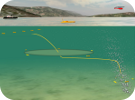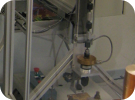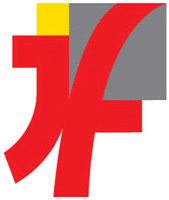Transportation networks and vehicular systems
Carlos Canudas de Wit
![]()
Alain Kibangou
![]()
Enrico Lovisari ![]()
Giovanni De Nunzio ![]()
Pietro Grandinetti ![]()
Andrés A. Ladino Lopez ![]()
The group objectives
Part of the NeCS team is formed by the group on traffic modeling & control; it deals with traffic modelling and control, flow regulation, traffic estimation and prediction; distributed sensing, as well as control and communication in a traffic network, also constitutes an active area of research.
Research topics
Traffic modelling and forecasting
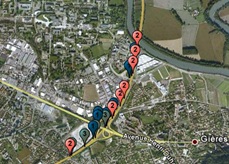
Part of the Grenoble south ring equipped with magnetic sensors
For an efficient implementation of an intelligent transportation system, real-time network information should be broadcast to the travelers. Since location and severity of congestion within the transportation network change continuously, it is opportune to derive new model-based traffic forecasting policies, that allow to predict the travel time as accurately as possible; to this end, in addition to flow measurements provided by different sensors, it is necessary to reconstruct unmeasured quantities (the densities), and predict travel demands at different access points of the network.
Freeway traffic optimization via collaborative ramp metering
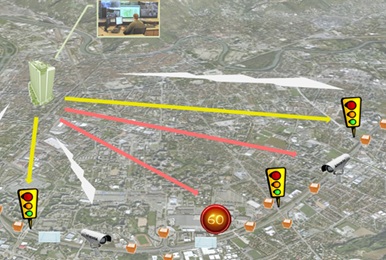
Ramp metering in the Grenoble south ring
The goal of the research is the redesign of new control policies (ramp metering) that use collaborative information from neighbors-controlled ramps to control the input flows at the on-ramps, without necessarily go to a completely centralized control design, that uses the full set of information. The control method aims at regulating the in-flow on some (or several) input ramps of the road; this control setup is highly effective in regulating flows and densities on the main lane, at the price of reallocate the vehicles distribution into other parts of the network (usually at upstream location of the considered network, where demands are lowers).The work will focus on the development of new control methods and their associated software to make this method feasible; the proposed algorithms for estimation and control methodology will be tested on a micro simulator.
Control of communicating vehicles in urban environment
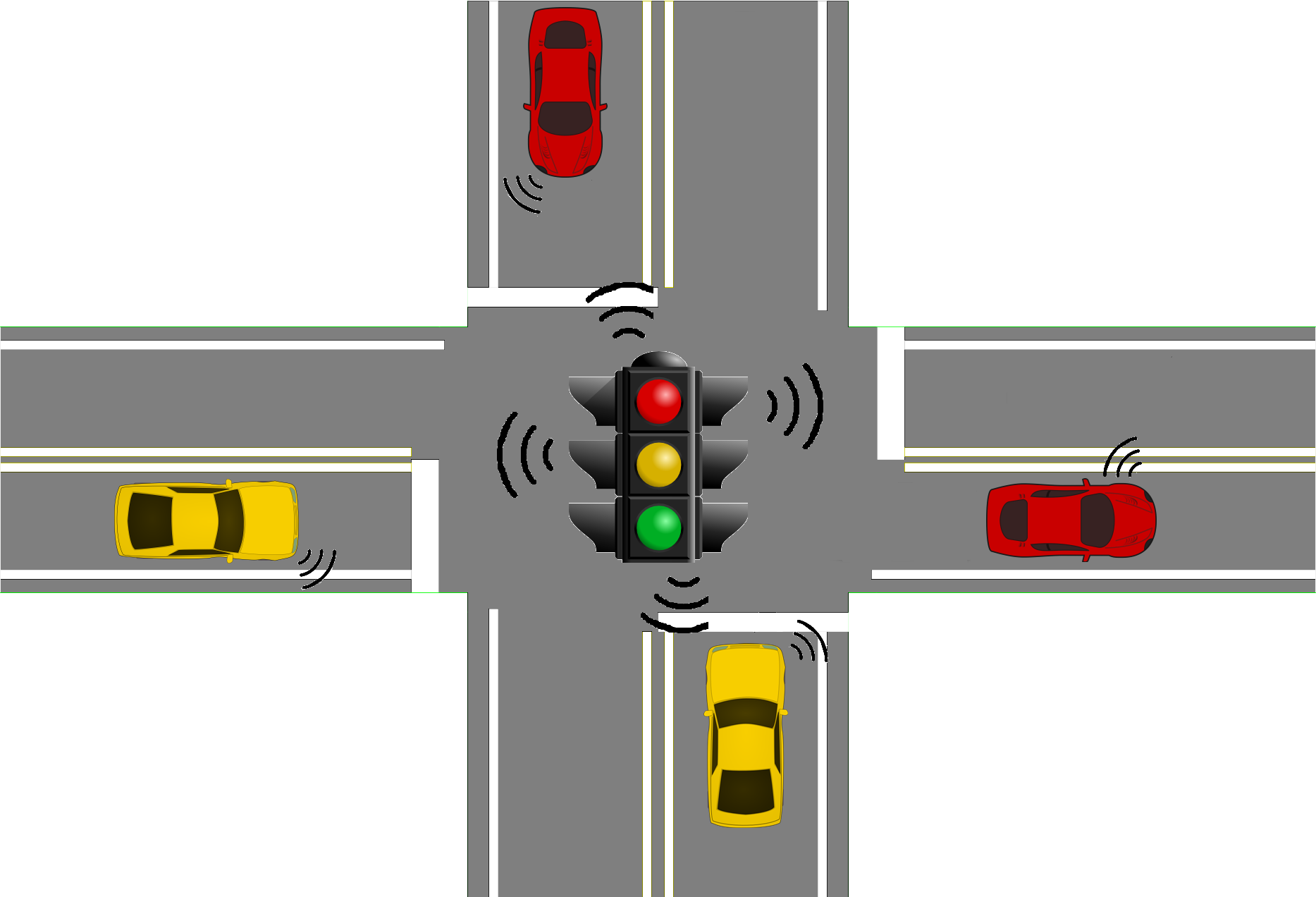
Vehicles and road infrastructure can communicate to optimize traffic flows
For a given vehicle there are different ways to travel on a given distance in a given time, corresponding to different levels of energy consumption; therefore, there is an energy-optimal trajectory. Advising the driver via a suitable interface can reduce the energy consumed during the travel, and thus improve the energy efficiency: this is the principle of eco-driving. In urban areas, the optimal trajectory of the vehicle depends on interactions with other vehicles, but also on passive signs (panels, priorities, etc.) and active signs (traffic lights); in each case, constraints are imposed on the command (vehicle speed). From the infrastructure perspective, traffic control in urban areas consists in determining the state of traffic signals in order to solve an optimization problem, for example minimizing travel time of vehicles in the road network. If all the vehicles can communicate with one another and with the active infrastructure (traffic lights), we can imagine benefits for each of the two problems which can be considered as a whole: on the one hand, from the vehicles' point of view, more information is available that can be integrated into the online optimization problem; on the other hand, there are new measures and new commands available to control traffic. Indeed, the estimation of the traffic is no longer necessary, as the position and speed of approaching vehicles is known. More importantly, the traffic manager can send instructions to the vehicle. The aim of the research is to evaluate the potential in terms of energy saving and traffic improvement made possible by communicating vehicles.
Design of electronic power assistance steering (EPAS) system for disabled people
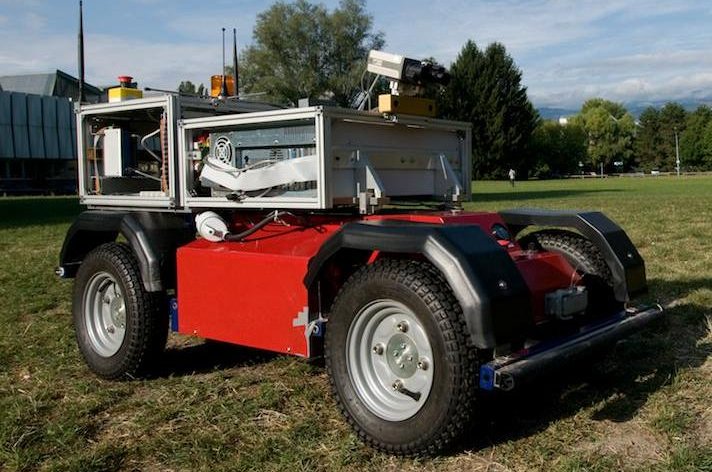
Part of the EPAS hardware-in-the-loop setup
Disabled people face the effort to turn the steering wheel while driving their vehicle. This study, funded by the VolHand project, focuses on the aspect of the assistance during driving manoeuvre at low speeds (for instance, parking). On common vehicle for healthy people, the system that improves the driver' steering feel in these situations is the power steering stage, which is mounted at the basis of the steering column and is based on hydraulic technology; the new generation uses an electric motor instead of the hydraulic pump, with more advantages in terms of fuel consumption, better road feel feedback to the driver and better return-to-center performances of the steering wheel.
The work has the goal to develop a general methodology to adapt the current technology for disabled people, by introducing additional blocks that can be implemented via software without altering the hardware of the vehicle. In this way, it can be easily exported without additional costs in terms of design and technology for the industrial partner. The methodology has been studied theoretically, joining control aspects with biomechanical ones; moreover, the theoretical study has been tested in laboratory on the hardware in the loop setup: a real steering wheel is linked to a real time PC-unit and to an electrical motor. A graphical user interface has been implemented to facilitate the access to the software. The last part of the study will consist into the experimental validation of the methodology with a teleoperated real vehicle. This vehicle will provide the measure of the friction torque to the PC-unit, allowing us to simulate a real driving situation.
Grenoble Traffic Lab
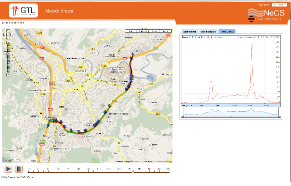
The GTL macro-simulator
GTL is built in public and private regional partnership, an innovative wireless sensor network for traffic data collection. The main purpose of the project is dealing with congestion, flow regulation and road network optimization on Grenoble south ring; it aims at collecting, sensing, and aggregating real-time data for traffic modelling, prediction and control. The team uses real data, but also simulated data, in order to validate models and to test the ramp-metering.
The micro-simulator is a commercial software (developed by TSS AIMSUN ©) used for several purposes, like very precise mapping on AutoCAD Blueprint, comportment, flow, velocity reaction-time calibration, real data inputs and validation. The team has created a software demonstrator to have a showcase including cutting-edge model developments; this software is a global services platform for end-user traffic use, providing accurate density calculation on traffic color vision, and integration of estimator and prediction motor for travel-time calculation.
Selected papers
- F. Morbidi, L. León Ojeda, C. Canudas de Wit and I. Bellicot, Robust mode selection for accurate traffic density estimation, IEEE European Control Conference, 2014.
- L. León Ojeda, Alain Y. Kibangou and C. Canudas de Wit, Online dynamic travel-time prediction using speed and flow measurements, IEEE European Control Conference, 2013.
- L. León Ojeda, Alain Y. Kibangou and C. Canudas de Wit, Adaptive Kalman filtering for multi-step ahead traffic flow prediction, IEEE American Control Conference, 2013.
- D. Pisarski and C. Canudas de Wit, Optimal balancing of road traffic density distributions for the Cell Transmission Model, 51th IEEE Conference on Decision and Control, 2012.
- V. Ciarla, V. Cahouet, C. Canudas de Wit and F. Quaine, Genesis of booster curves in electric power assistance steering systems, 15th IEEE Intelligent Transportation Systems Conference, 2012.
- C. Canudas de Wit, L. León and A. Kibangou, Graph constrained-CTM observer design for the Grenoble south ring, 13th IFAC Symposium on Control in Transportation Systems, 2012.
- D. Pisarski and C. Canudas de Wit, Analysis and design of equilibrium points for the cell-transmission traffic model, IEEE American Control Conference, 2012.
- C. Canudas de Wit, Best-effort highway traffic congestion control via variable speed limits, 50th IEEE Conference on Decision and Control, 2011.
- D. Jacquet, C. Canudas de Wit and D. Koenig, Optimal control of systems of conservation laws and application to non-equilibrium traffic Control, 13th IFAC Workshop on Control Applications of Optimization, 2006.
- D. Jacquet, C. Canudas de Wit and D. Koenig, Traffic control and monitoring with a macroscopic model in the presence of strong congestion waves, 44th IEEE Conference on Decision and Control and European Control Conference, 2005.
- D. Jacquet, C. Canudas de Wit, J. Jaglin and D. Koenig, Non-local feedback ramp metering controller design, 11th IFAC Symposium on Control in Transportation Systems, 2006.
- D. Jacquet, C. Canudas de Wit and D. Koenig, Optimal ramp metering strategy with extended LWR model; analysis and computational methods, 6th IFAC World Congress, 2005.
 Go to the full list of publications
Go to the full list of publications


